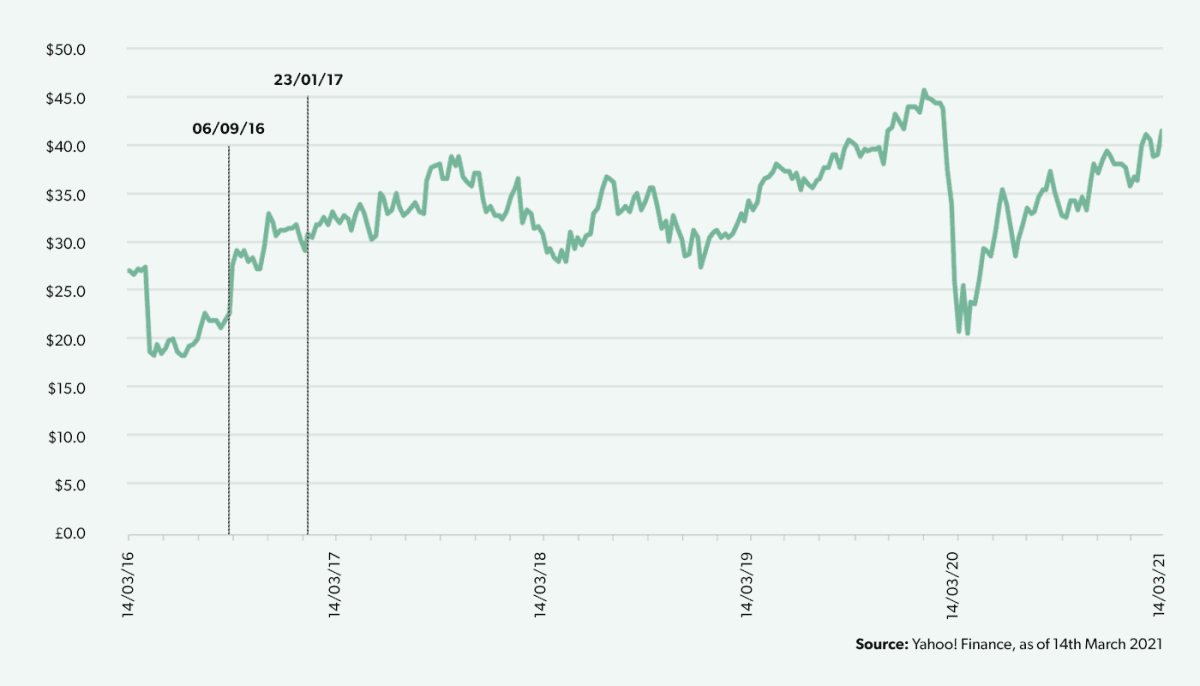In January 2017, Liberty Media completed the acquisition of Formula One Group from former owners CVC Partners in a deal reported to be worth $8bn.
That acquisition caused some surprise as a 2012 private sale of F1 equity valued the series at $9.1bn, meaning 12% of that value had eroded in the four years before Liberty made their binding cash and stock offer. The below table shows the implied valuations at three significant events: the acquisition by CVC Partners in 2006, the above-mentioned sale of a 28.3% stake to Norway’s sovereign wealth fund Norges along with money managers Blackrock and Waddell & Reed in 2012 and the Liberty acquisition in 2016.
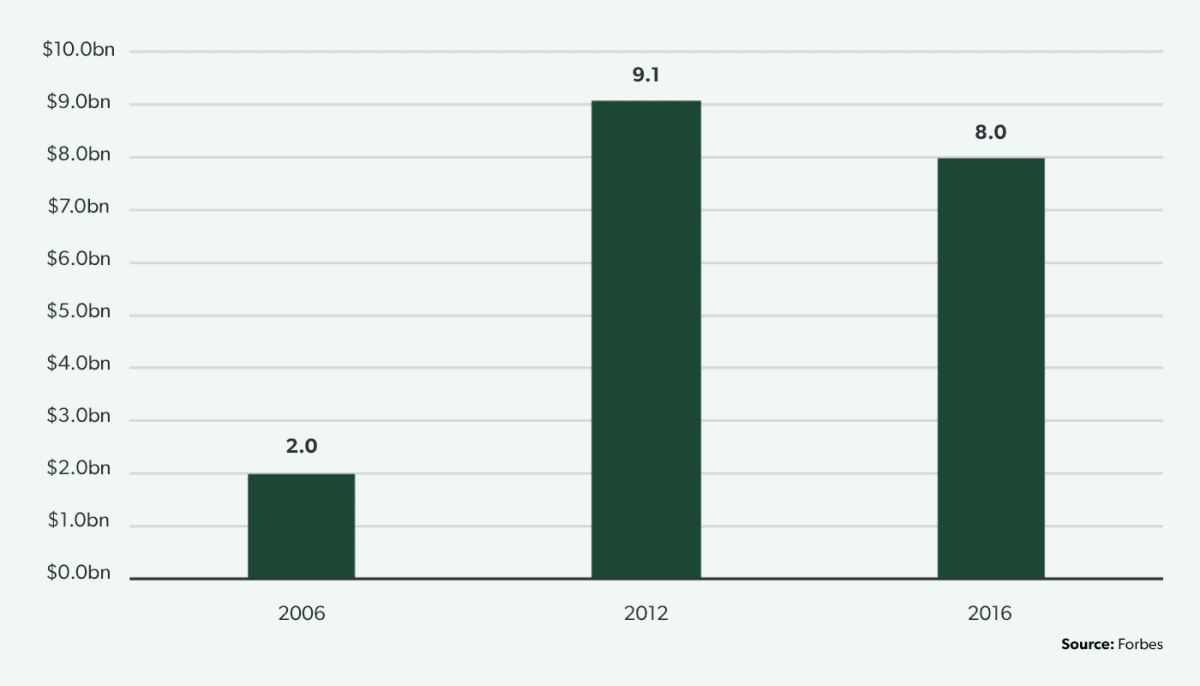
CVC still made a very healthy return on its 2006 purchase at a valuation of $2bn, but according to a Forbes report from September 2016 when the sale was announced, “F1 was leaving billions of dollars on the table thanks to decisions that have diminished fan interest and created vast financial inequalities among the teams”. Looking at how Liberty have managed the competition since taking control will establish the extent to which this statement was true.
The world’s premier motor racing series
Before looking at the impact Liberty has had, some background. The first Formula One world championship race took place at the Silverstone track, near the village of the same name in Northamptonshire in the UK on the 13th of May 1950. Before the war, Grand Prix racing organisations had begun to set out rules for a new world racing championship but racing was suspended and the World Drivers' Championship was not formalised until 1947. The drivers’ competition was supplemented with a contest between constructors in 1958 and while non-championship F1 events continued to be held in addition to the main competition for a quarter of a century, these were stopped in 1983 due to the prohibitively high running costs.
Formula One has steadily increased in size and scale since its inception. In 1950 there were seven races, all but one in Europe (the United States hosted the Indianapolis 500 from the inaugural year of the competition). In 2021, races are planned in a record 23 locations, of which 11 are in Europe and four each in the Americas, Middle East/Africa and Asia Pacific. The first 30 years of racing saw new races added regularly to reach 17 for the first time in 1977. For the two decades from 1984 to 2003 the competition struggled to expand beyond that number, before growth resumed and has only been interrupted to any significant extent in 2020 when Covid-19 restrictions caused the original plan for 22 races to be downsized to 17 as many races were cancelled not all were replaced.
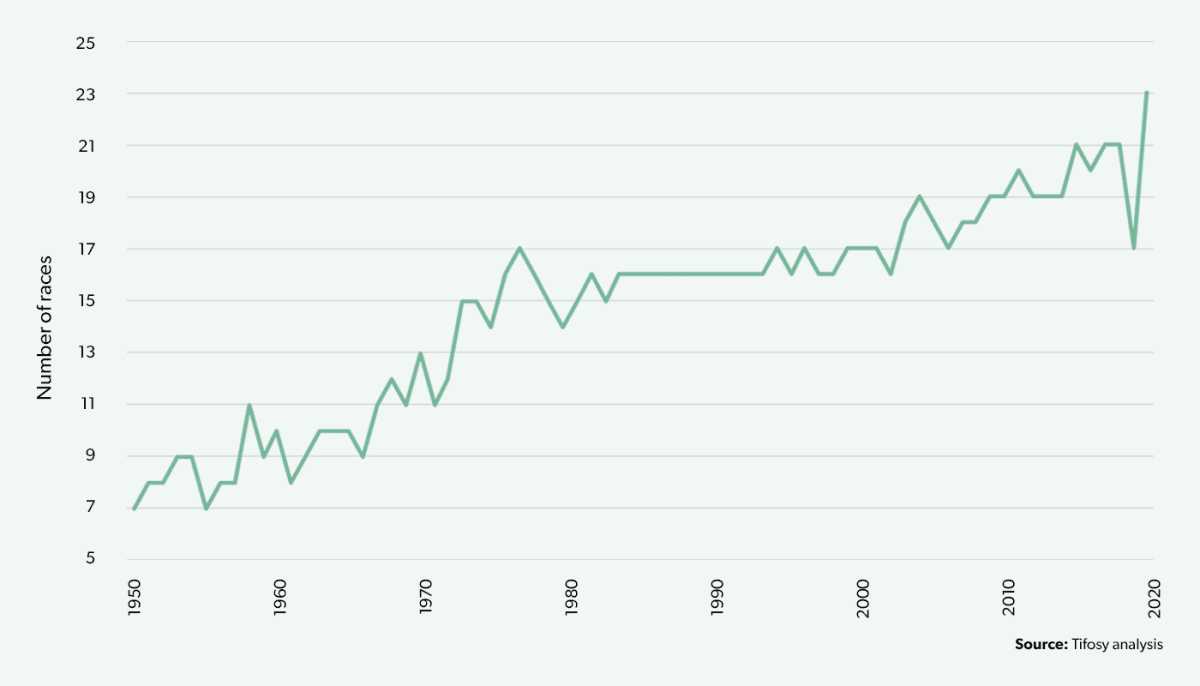
While Formula One has sought to become a more global set-up, it remains predominantly focused in Europe where the majority of the world’s most famous circuits – and therefore races – were built in the early years. Events hosted in Europe accounted for two-thirds of each decade’s races up to and including the 1990s, before falling to 56% in the first decade of the new millennium and 45% in the 10 years to 2019. Races in the Americas have also declined, from a peak of 26% in the 1970s and 1980s to 16% in the last decade. The major growth has come from Asia Pacific &ndash: from just two races in Japan in the 1970s to 61 in the 2010s across Australia, Malaysia and more recently China, India, Russia, Singapore and South Korea. The Middle East has risen to a lesser extent through Bahrain, the United Arab Emirates and Azerbaijan. The first Formula One race in Saudi Arabia is scheduled to take place in Jeddah in December 2021.
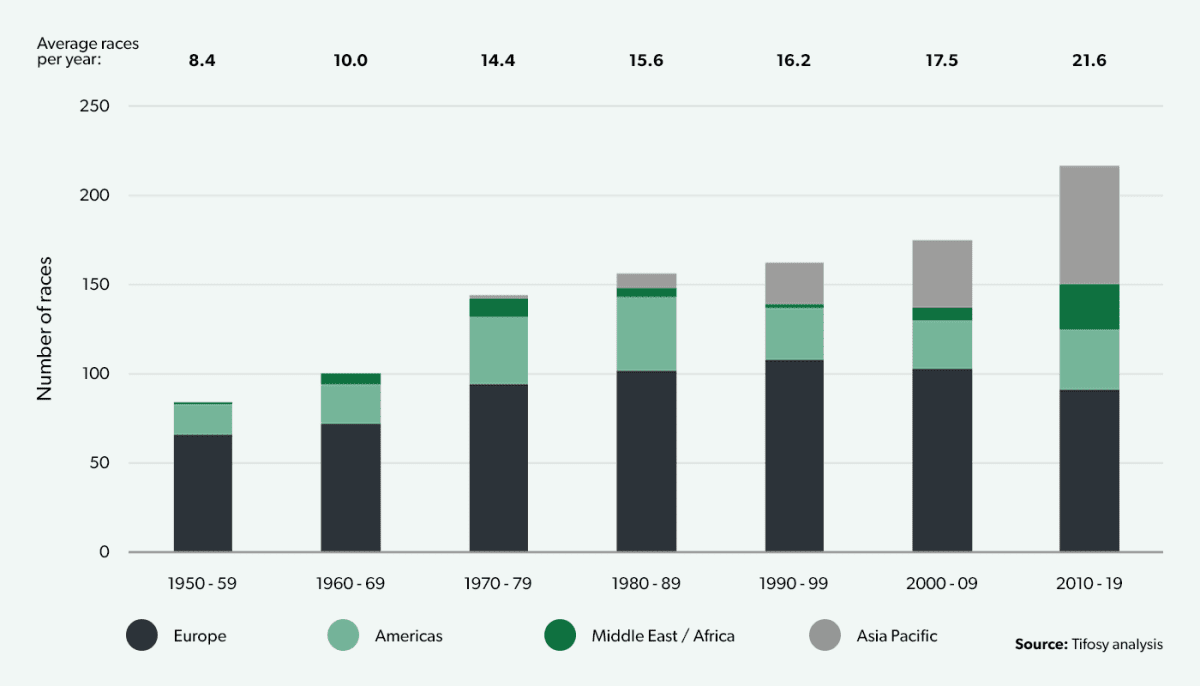
Revenues in growth until Covid-19 hit
Formula One went from a $1.5bn revenue competition to just over $2.0bn in 2019, before seeing a fall of 43% in 2020 due to Covid-19 cancellations and restrictions. Growth was not steady and consistent however, with drops in 2014 and 2017, the latter being Liberty’s first year as top shareholder. But the new owners appear to have had an impact after their first year: after adding $43m to the top line in 2018, moving the franchise back to growth at a rate consistent with the previous six years, 2019 saw growth of £195m, up 11% and 4.5x the prior seven year growth rate. It seems Liberty were just getting into top gear before the pandemic raised the yellow flag.
The competition prize fund has also grown, in absolute and as a percentage of revenues. Prior to 2020 when the fund of $711m accounted for 62% of revenues, prize monies had grown from $699m (46% of revenues) in 2011 to just over $1.0bn (50% of revenues) in 2019, although this is down from the peak of 55% in 2016 when the prize fund had been growing an average of five points ahead of revenues for four consecutive years.

Liberty focusing on digital growth
Bernie Ecclestone, the long-serving chief executive of Formula One until Liberty Media’s acquisition, was famously less interested in the digital development of the series. Indeed, he was once quoted as saying:
I’d rather get to the 70-year-old guy who’s got plenty of cash. So there’s not point trying to reach these kids because they won’t buy any of the products here and if marketers are aiming at this audience, then maybe they should advertise with Disney
Since Liberty took over, digital has been a major focus. Under the leadership of Frank Arthofer, previously of ESPN, the company launched the Formula 1 eSports series and linked social media channels, the digital subscription service F1 TV with its dual-tiered Pro and Access offerings, the “Beyond the Grid” podcast launched in June 2018. There is a renewed focus on gaming in terms of both the F1 video game series and the F1 Fantasy game. March 2019 saw the launch of a new docuseries in partnership with Netflix, Drive to Survive. The series offers a behind-the-scenes look at the drivers and races of the F1 championship and has been a major success, with the third season hitting screens last week.
Since Liberty took over, Formula 1 has launched an eSports series, digital subscription service and podcast, and placed greater focus on gaming in terms of both the F1 video game series and the F1 Fantasy game

As Chase Carey, CEO of Formula One from the acquisition until the end of 2020 noted in an interview with the FT in May 2018, “In a world where digital technology is changing everything, [live] event content is gaining value as other forms of content become more commoditised. [F1] is well positioned to increase in value”.
The focus on digital is perhaps most apparent in Formula One’s social media growth: following has increased from 7.7m in 2016 to 35.0m in 2020, an increase of 355%. This compares to a growth in broadcast audience of only 11% in the same period, from 390m in 2016 to 433m in 2020, according to official published figures. According to the official F1 site, engagement on its social media platforms (Facebook, Twitter, Instagram and YouTube) was up 99%, significantly ahead of the next largest growth amongst sports leagues (Bundesliga and UFC at 48%).
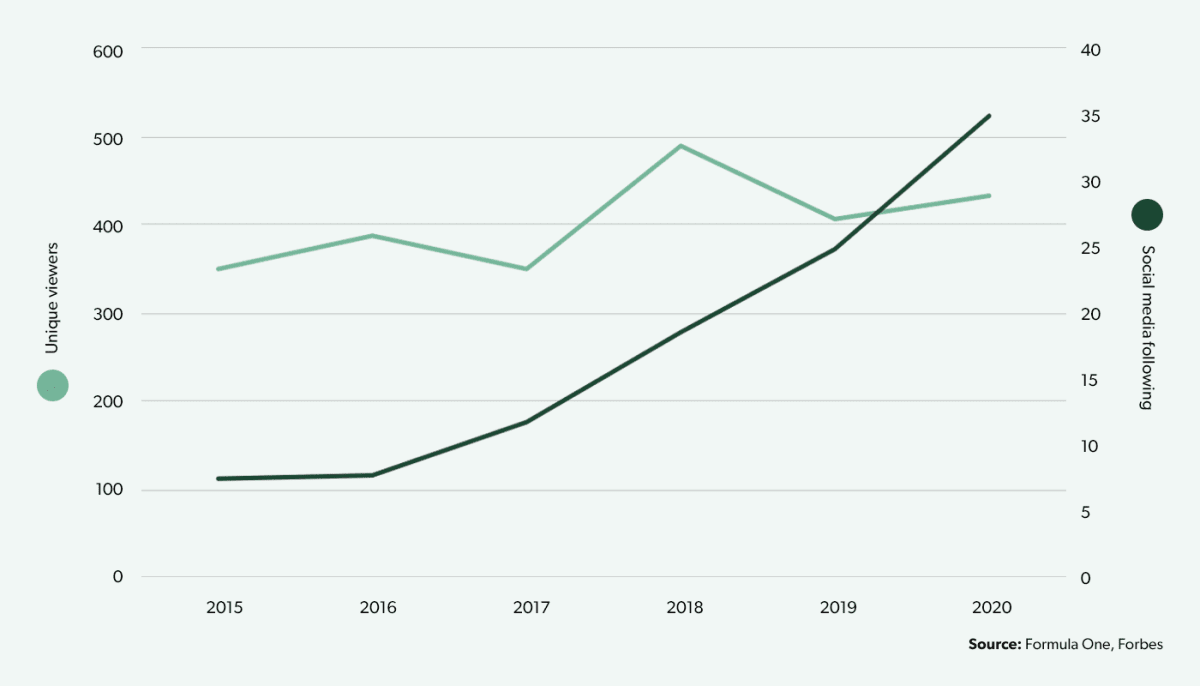
Stock price rises under Liberty management
On the announcement of Liberty Media’s acquisition of Formula One, the share price began to rise, from $22.74 the day before the announcement to $30.93 on the day the new owners took charge (January 23rd, 2017), an increase of 36%. From that date, the price rose to a high $45.67 – a further increase of 48% - by 13th January 2020, shortly before the impact of Covid-19 started to be felt. Following a low of $20.61 in the early days of the pandemic, the price has risen steadily again, to $42.72 – just 6% shy of the peak.
